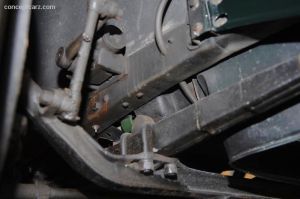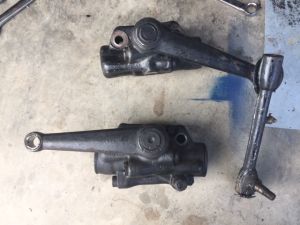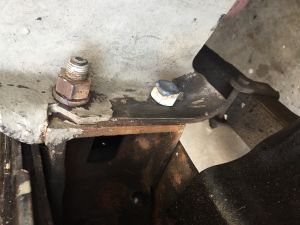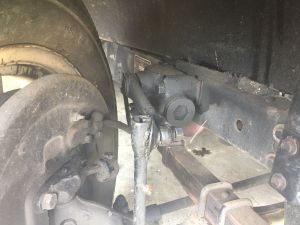- Home
- About Us
- Join/Renew
- Member Benefits
- Member Pages
- Log In
- Help
- Museum Store
It occurred to me that the difference between the left and right shock on an axle would be jouncevand rebound swap. Perhaps one can swap the two valves in the shock plus the lever arm, to accomplish this. Not certain though.
New information: I gleaned this chassis photo of a 1931 Series 43 from the internet this afternoon. It clearly shows the steel shim underneath the shock on the passenger-front side, exactly as I found on my Car. Note the folded end of the shim on the forward end, presumably this aligns the shock perpendicular to the front axle and makes up for the taper of the frame rail.
I would like to see the other side, but alas! it was not available. I am curious about that steel pad welded to my
Car’s frame on the driver’s side.

Greg, I don’t understand the numbering system, but “1650” is promising at least. The right-hand shocks will have the arm pointing to the right with the two mounting holes at the top; the left (driver’s side) will have the lever arm pointing to the left with the holes on top.
The front arms on my car are straight; I have not looked at the rear shocks yet.
Correction to my earlier post: the oddball shock is on the driver’s side; the shock 1650 F which I think may be correct, is on the passenger side. I used a confusing mix of right-left as I was facing the Car’s front, vs. the reality that the left of the Car is in fact the driver’s side.
Well, well… the Gentle Giant (1931 Series 43) has a different-model shock on the right-front: it appears to be a spare retrieved from a car equipped with ride control. See photo for a comparison (the shock with the link attached is from the passenger-side).
The model numbers are: passenger side is 1650 F; driver side is 1652 PY and it has a ride control with the lever sawn off.
Because of the difficulty in removing the right-front unit, it could well be original and never removed, or at least not in a long time. I don’t understand the numbering system and I can’t yet determine what the correct shock is. There is a 1652 PY on Ebay being offered as a Packard shock.
There is some indication there is a right and left unit, and of course the front and rears are different, so if anyone can shed light on the correct shock for the 1931 Series 43 that will be a great help.
Another little blip: the shock on the passenger side has a steel shim between it and the frame. There is a rectangular steel pad welded to the frame on the driver side, very neatly, and the shock is bolted on here. The bolt pattern on both shocks is the same and the thickness of the shock body through which the mounting bolts pass is the same. I have no idea if the welded-on pad is original, or was added later. It is neat enough to be factory original, as far as appearance goes.

Replaced the broken bolt with a stock, Grade 5 bolt. Fit perfectly.
Now to tackle the other side, to see what we have there…
Lest any doubts remain, and because you might find this interesting, I offer a link to the web page of a vendor we have used for years. The repair processes they use are very nicely documented and illustrated.
Connecting rod knock the side out of a 10,000 HP engine? wipe out a main bearing saddle? No problem.
Great fix, thanks for sharing. Gotta find a way forward, so there!
Hi, Greg; I will get the photos of that bolt online. The broken one is not the one that passes through the Lovejoy, so it’s shorter at least.
I could always get a machinist to knock one out if we can’t come up with one; I’m thinking of 4140HT.
Got the bolts out, Lovejoy out of the way, etc. so now what to do? The three bolts involved are obviously purpose-made for the application, rather than something off-the-shelf. I will have to find a bolt to replace the broken one; the other two can be reused. I suspect they were originally fit into a reamed hole which got very tight with a little corrosion. The rust was otherwise not that extensive.
Peter, I do use PB Blaster and it’s good stuff; I picked up my can and it said “Pffft” so it was out. I also use AeroKroil, the favorite spray of the Solar Gas Turbine techs I encounter frequently in my professional life. My Granddad was an old-time auto and equipment mechanic and he called it all “PantherP!33”.
A photo of the passenger-side engine mount. The top bolt with the nut on is also the rear bolt holding the Lovejoy shock. The bottom bolt is the broken one that started all this work. Here I have welded a nut on it, thinking it was a broken stud. Surprise!

I made significant progress this afternoon. Turns out the shocks on my 1931 Series 43 are held on by two bolts which pass through holes in the shock body, rather than the blind studs some Lovejoys used. The front bolt has a nut readily accessible on the inside of the frame, no problem. The rear bolt also serves as the top bolt for the passenger-side engine mount; again with the nut to the inside and easily accessible.
After removing the nuts, both bolts were rusted tightly in place and would not budge. Liberal application of a 6-pound hammer to the poor sacrificial nut plus plenty of WD-40 and a 3-foot breaker bar and “leverage magnification device†(cheater pipe) and the front bolt finally gave up and came out. I have sprayed the tear bolt and moved it quite a bit; I am allowing it to soak for a while.
Thanks for the advice and help!

You are right; photos coming.
They are the Lovejoy shocks. There is one bolt with a nut and lock washer on the inside of the frame, very visible. It seems to pass through a casting or forging riveted to the inside of the frame, and this also seems to be the part which the front engine support bolts to. The two bolts pass through the part and one bolt head is too close to the shock body to remove without moving the shock. I cannot see the other bolt head, and I think it must be behind the shock.
Sad day, and yet Pierce-Arrows are still gracing America’s motorways with dignity and grace, every additional mile proving the lasting value of their supreme quality.
Only photo I have, so far…
Ok thanks!
Should read 1931 Series 43
It’s a car I bought.
Thanks!
Would a ’31 Series 43 5-passenger sedan have a rubber mat in front and carpet in the rear, as original?
Gauges can and do lie, but it may be telling the truth. My advice is to first use a known good gauge of the appropriate pressure range, connect it to the engine, and compare readings. You could possibly have erratic pressure because of a failing pump, a crack in a vital part, tube, etc, or another problem. In the case of oil pressure, it is wise to be sure. Hope this helps!
